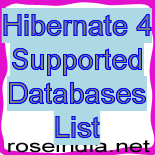Hibernate 4 Supported Databases List
In this tutorial you will learn that how many databases are supported by Hibernate. You must be looking for the list of database which is being supported by Hibernate ORM.
Hibernate is an ORM framework (Object Relational Mapping) which hides the complexity of JDBC code involved in accessing the database and behalf of client (Java program) it talks to database to perform various query against database.
Java program receives the data in the form of Java objects which is called as POJO classes. Hibernate framework is very popular and in modern day application it is used as important framework.
Hibernate framework is also database independent, which means you can develop your program for one database and later point of time it can be configured to work with other databases. This feature of Hibernate is handled by 'Dialect' classes and for every database this class is different.
For example for MySQL org.hibernate.dialect.MySQL5Dialect is used, while for oracle org.hibernate.dialect.Oracle10gDialect class is used. This tutorial gives you the list of Hibernate supported databases with the name of Dialect to be used for that database.
Here is the video tutorial of: "Hibernate 4 Supported Databases List"
Hibernate supports various of databases. Here we are giving some of the Hibernate supported database list and their respective dialect i.e hibernate.dialect.
| RDBMS | Dialect |
| MySQL5 | org.hibernate.dialect.MySQL5Dialect |
| MySQL5 with InnoDB | org.hibernate.dialect.MySQL5InnoDBDialect |
| MySQL with MyISAM | org.hibernate.dialect.MySQLMyISAMDialect |
| Oracle (any version) | org.hibernate.dialect.OracleDialect |
| Oracle 9i | org.hibernate.dialect.Oracle9iDialect |
| Oracle 10g | org.hibernate.dialect.Oracle10gDialect |
| Oracle 11g | org.hibernate.dialect.Oracle10gDialect |
| DB2 | org.hibernate.dialect.DB2Dialect |
| DB2 AS/400 | org.hibernate.dialect.DB2400Dialect |
| DB2 OS390 | org.hibernate.dialect.DB2390Dialect |
| PostgreSQL | org.hibernate.dialect.PostgreSQLDialect |
| Microsoft SQL Server 2000 | org.hibernate.dialect.SQLServerDialect |
| Microsoft SQL Server 2005 | org.hibernate.dialect.SQLServer2005Dialect |
| Microsoft SQL Server 2008 | org.hibernate.dialect.SQLServer2008Dialect |
| SAP DB | org.hibernate.dialect.SAPDBDialect |
| Informix | org.hibernate.dialect.InformixDialect |
| HypersonicSQL | org.hibernate.dialect.HSQLDialect |
| H2 Database | org.hibernate.dialect.H2Dialect |
| Ingres | org.hibernate.dialect.IngresDialect |
| Progress | org.hibernate.dialect.ProgressDialect |
| Mckoi SQL | org.hibernate.dialect.MckoiDialect |
| Interbase | org.hibernate.dialect.InterbaseDialect |
| Pointbase | org.hibernate.dialect.PointbaseDialect |
| FrontBase | org.hibernate.dialect.FrontbaseDialect |
| Firebird | org.hibernate.dialect.FirebirdDialect |
| Sybase | org.hibernate.dialect.SybaseASE15Dialect |
| Sybase Anywhere | org.hibernate.dialect.SybaseAnywhereDialect |
In the above table you can see that the RDBMS names and their respective dialect that will be used in the hibernate.cfg.xml. It means which database you will be used in your application to persist the object you will have to use their respective dialect.
